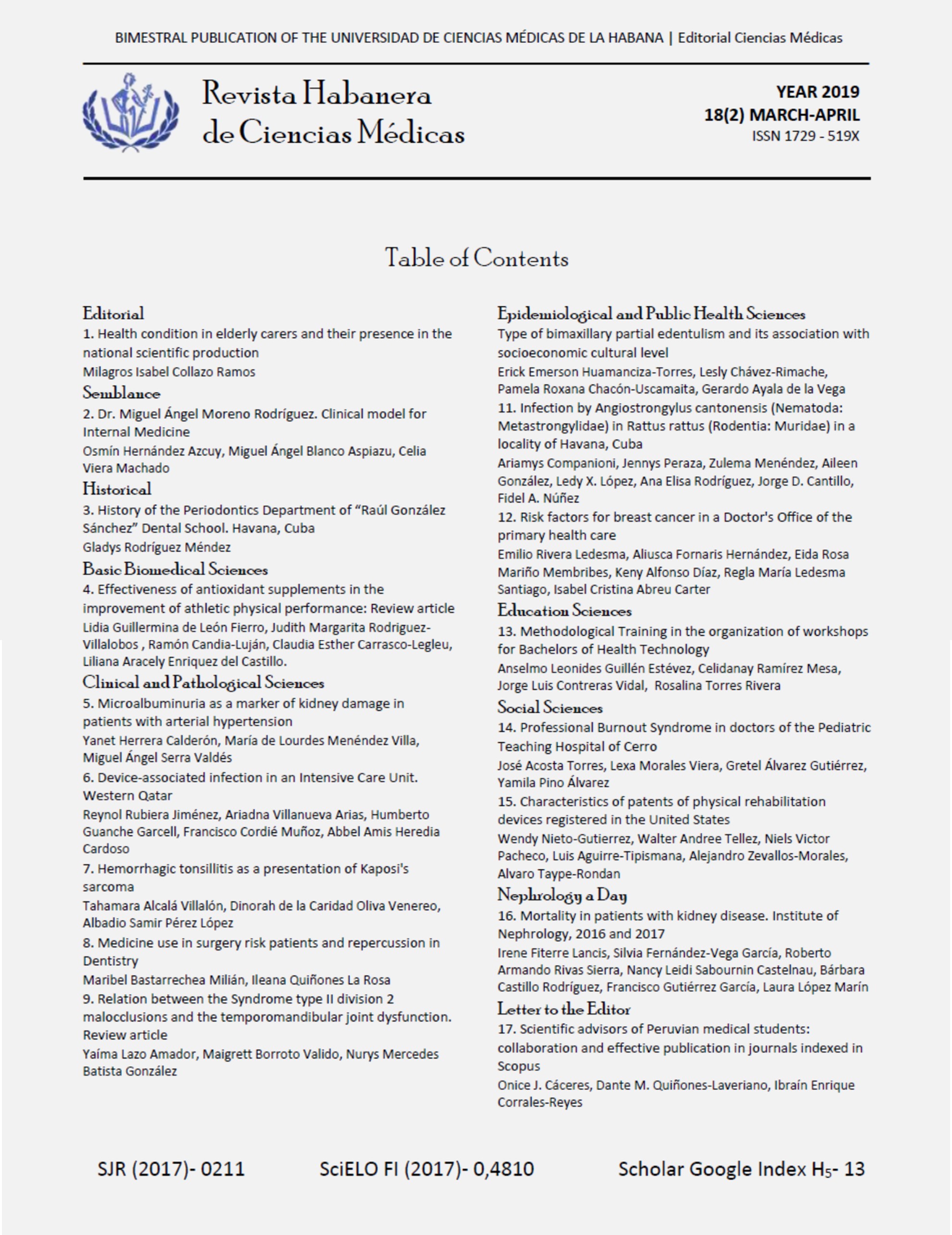Relation between the Syndrome type II division 2 malocclusions and the temporomandibular joint dysfunction. Review article
Keywords:
Síndrome clase II división 2, disfunción temporomandibular, mordida profunda, maloclusión.Abstract
Introduction: Patients with Syndrome type II division 2 malocclusions, besides presenting a clinically established relationship between molars and canines in a distal occlusion, show a retro-inclination of the upper front teeth with pro-inclination of the lateral incisors and a deep overbite, which can result in a risk factor of temporomandibular dysfunction.
Objective: To identify the relationship between Syndrome type II division 2 malocclusions and the temporomandibular dysfunction.
Material and Methods: A bibliographic review was carried out through a search of databases such as MEDLINE, PubMed, Hinari, and Scholar Google. A total of 17 articles were used.
Development: Because of the clinical characteristics of the occlusion in the patients with this syndrome, the range of jaw movement is limited, producing a traumatic effect that is related with a position of the condyles displaced backward and with glenoid fossa intrusion. This more distal displacement produces the pressure of the richly innervated retrodiscal tissue, which could be the cause of inflammation of the surrounding tissues and the affectation of the joint function due to an elongation of the discal ligaments or a thinning of the disc affecting the disc-condyle complex.
Conclusions: The studies conducted demonstrate the relationship between the Syndrome type II division 2 and the temporomandibular joint dysfunction, given the clinical characteristics that are present in this syndrome, which affect the functioning of the temporomandibular joint, and produce its dysfunction when exceeding the adaptive capacities of the patient.
Keywords: Syndrome type II division 2 malocclusions, temporomandibular dysfunction, deep overbite, malocclusion.
Downloads
References
1. Otaño LR, Marin MG, Massón BR, Fernández YR, Llanes R M, Cruz RY, et al. Origen y evolución de la Ortodoncia en: Ortodoncia. La Habana: Editorial Ciencias Médicas; 2014. p.3-4.
2. Verdugo Barrazal ML. Comparación cefalométrica entre sujetos con oclusión normal y clase ll división 1. Rev Cubana Estom [Internet]. 2004 Abr [Citado 9/10/2017]; 41(1): [aprox. 6 p.]. Disponible en:
http://scielo.sld.cu/scielo.php?script=sci_arttext&pid=S0034-75072004000100006
3. Rodríguez Manjarréz C, Padilla Tello MR. Manejo temprano de la maloclusión clase II división 2.Revisisón de la literatura. Rev Estom [Internet]. 2015 [Citado 9/10/2017]; 23(2):57-63. Disponible en: http://estomatologia.univalle.edu.co/index.php/estomatol/article/view/417
4. Pinos Luzuriaga A, Siguencia V, Bravo Calderón M. Tratamiento de maloclusiones de Clase II división 2. Revisión de la literatura. Rev Latin Ortod Odontoped [Internet]. 2015 Ene [Citado 9/10/2017]; [aprox. 10 p.]. Disponible en:
https://www.ortodoncia.ws/publicaciones/2015/art-3/
5. Pereira PM, Ferreira AP, Tavares P, Braga AC. Different manifestations of class II division 2 incisor retroclination and their association with dental anomalies. J Orthod, 2013; 40(4):299-306.
6. Otaño LR, Marin MG, Massón BR, Fernández YR, Llanes R M, Cruz RY, et al. Diagnóstico de las anomalías dentomaxilofaciales en: Ortodoncia. La Habana: Editorial Ciencias Médicas; 2014. p. 108-9.
7. Kirschneck C, Römer P, Proff P, Lippold C. Association of dentoskeletal morphology with incisor inclination in angle class II patients: a retrospective cephalometric study. Head Face Med [Internet]. 2013 Sep [ Cited 9/10/2017]; 9:24. Available from: https://www.ncbi.nlm.nih.gov/pmc/articles/PMC3846714/
8. Paduano S, Spagnuolo G, Biase G d, Cioffi I. Treatment of a Class II division 2 patient with severe skeletal discrepancy by using a custom made TPA proclinations pring. Open Dent J [Internet]. 2013 [Cited 9/10/2017]; 20(7):109-17. Available from: https://www.ncbi.nlm.nih.gov/pmc/articles/PMC3805986/
9. Cossío EM, Lema ÁMC. Como pide nuestro cuerpo la ortodoncia. CES Odontol. 2014; 27(1):91-103.
10. Montero Parrilla JM, Denis Alfonso JA. Los trastornos temporomandibulares y la oclusión dentaria a la luz de la posturología moderna. Rev Cubana Estom [Internet]. 2013 Dic [Citado 9/10/2017]; 50(4):408-421. Disponible en: http://scielo.sld.cu/scielo.php?script=sci_arttext&pid=S0034-75072013000400008
11. García-Fajardo Palacios C, Cacho Casado A, Fonte Trigo A, Pérez Varela JC. La oclusión como factor etiopatológico en los trastornos temporomandibulares. RCOE [Internet]. 2007 Jun [Citado 9/10/2017]; 12(1-2): 37-47. Disponible en:
http://scielo.isciii.es/scielo.php?script=sci_arttext&pid=S1138-123X2007000100003&lng=es
12. Moreno Rojas M, Lara Mendieta P, Meléndez Ocampo AF. Perfil clínico epidemiológico del trastorno temporomandibular en mexicanos con maloclusión. Rev Mexicana Ortod [Internet]. 2015 [Citado 9/10/2017]; 3(2):79-83. Disponible en: http://www.medigraphic.com/pdfs/ortodoncia/mo-2015/mo152b.pdf
13. Soto Cantero L, De la Torre Morales JD, Aguirre Espinosa I, De la Torre Rodríguez E. Trastornos temporomandibulares en pacientes con maloclusiones. Rev Cubana Estomatol [Internet]. 2013 Dic [Citado 9/10/2017]; 50(4):374-387. Disponible en:
http://scielo.sld.cu/scielo.php?script=sci_arttext&pid=S0034-75072013000400005&lng=es
14. Murietta Pruneda JF, Pérez Silva LE, Allendelagua Bello RI, Linares Vieyra C, Juárez López LA, Meléndez Ocampo AF, et al. Prevalencia de chasquido en la ATM y su relación con el tipo de oclusión dental, en un grupo de jóvenes mexicanos. Rev ADM [Internet]. 2011 [Citado 9/10/2017]; 68(5):237-243. Disponible en: http://www.medigraphic.com/pdfs/adm/od-2011/od115f.pdf
15. Quijano Blanco Y. Anatomía clínica de la articulación temporomandibular (ATM). Morfolia [Internet]. 2011 [Citado 9/10/2017]; 3(4):23-33. Disponible en: http://www.bdigital.unal.edu.co/28094/1/26034-91249-1-PB.pdf
16. Sánchez Persona F F, Santos Vázquez D. Disfunciones craneomandibulares (dcm). Rev Act Clin Med [Internet]. 2012 [Citado 9/10/2017]; 20:1020. Disponible en:
http://www.revistasbolivianas.org.bo/scielo.php?pid=S2304-37682012000500005&script=sci_arttext
17. Prendes Rodríguez A M, Martínez Brito I, Faget MM. La disfunción temporomandibular y su relación con algunos factores de riesgo en niños de 7 a 11 años. Los Arabos, Matanzas. Rev Méd Electrón [Internet]. 2014 Ene-Feb [Citado 9/10/2017]; 36(1):15-24. Disponible en:
http://scielo.sld.cu/scielo.php?script=sci_arttext&pid=S1684-18242014000100003



